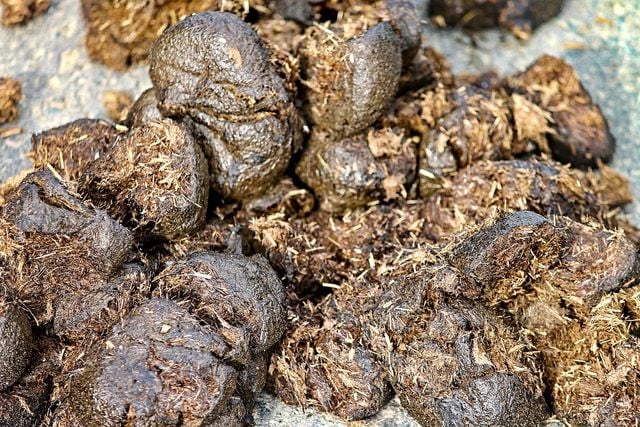With organic fertilizer you can provide nutrients to your plants in a natural way. In this article you will learn more about it.
Contents
- 1 Organic fertilizer: What is it?
- 2 Organic fertilizer: advantages and disadvantages
- 3 Organic fertilizers have the following advantages:
- 4 However, this is offset by these disadvantages:
- 5 Horn shavings and horn meal: Two organic fertilizers.
- 6 Compost: fertilize plants with humus soil
- 7 Horse and cattle manure
- 8 Bone meal: organic fertilizer with a bad reputation
- 9 Author
Organic fertilizer: What is it?
Organic fertilizer differs from mineral fertilizers in that it is mostly of plant and animal origin. The organic mixture is mixed into the plant soil, where it can release its nutrients. They are made available by water and soil organisms. However, this takes a little longer than with mineral (chemical) fertilizer.
Organic fertilizer: advantages and disadvantages

Organic fertilizers have the following advantages:
They are – as the name suggests – of natural origin and consist of plant or animal source materials. Therefore, organic fertilizer is sometimes also called “biofertilizer”.
Organic fertilizers not only provide the soil with nutrients – they also help prevent plant diseases.
Natural fertilizers break down slowly, so nutrients are released and absorbed more evenly than with mineral fertilizers.
As a result, they help build humus.
However, this is offset by these disadvantages:
It is harder to control which and how many nutrients are added to the soil. Organic fertilizers are therefore not suitable for correcting acute nutrient deficiencies.
In addition, most natural fertilizers contain only one or two nutrients. You can find out exactly what these are from the packaging.
Horn shavings and horn meal: Two organic fertilizers.
Horn shavings are crushed cattle hooves and horns. They are mainly used as nitrogen fertilizer -because nitrogen is particularly important for plant growth. However, it takes a relatively long time for the nutrients to become available.
Small ground horn shavings are called horn meal. This is somewhat more complex to produce. However, the nutrients are available to the soil more quickly than with horn shavings.
Compost: fertilize plants with humus soil
The compost pile in the garden is probably the best known organic fertilizer. Basically, anyone who has some free green space in their yard can build a compost pile and dispose of their organic waste there. The garbage is turned into fertile humus soil by microorganisms.
Here’s what you should keep in mind:
Cooked food scraps, sprayed fruit or bone waste do not belong on the compost.
It’s all in the mix: Lawn clippings, straw and leaves can be disposed of in the compost.
Simply spread the compost over your bed. In this way, you supply your plants with nutrients slowly and naturally – and you avoid overfertilization. In addition, the humus soil promotes the fertility of the soil and prevents the soil from becoming too acidic. As a result, plants might not thrive as much.
Horse and cattle manure

Horse manure and cattle manure are well-known organic fertilizers. They provide the soil with nitrogen, phosphorus and calcium and are often used together with compost. However, be careful not to use fresh manure, as it usually contains ammonia. Ideally, you should use manure dried in the sun – it can be up to a year old. Alternatively, you can mix the manure with compost (leaves, lawn clippings, etc.). Add this mixture to the beds after about a year by mixing a thin layer under the plant soil.
Drying the manure yourself is difficult in practice and takes a long time. Alternatively, you can use granulated or pelletized manure from a specialty store. Simply spread it on the soil and work it into the soil about five centimeters deep, for example with a garden rake. (You can find a sustainable model made of ash wood at **Avocadostore, for example).
Bone meal: organic fertilizer with a bad reputation
Bone meal is exactly what you think it is: ground bones. Basically, you can use bone meal on denser and not-so-sandy soils. This fertilizer provides the soil with phosphorus and calcium. When combined with horn shavings, bone meal co-contains most of the needed nutrients for fruit, vegetable and ornamental plants, making it ideal for them.
In the past, however, bone meal has come under increasing criticism: In the 1980s, according to the European Federal Ministry of Food and Agriculture, bone meal was partly responsible for diseases such as BSE being transmitted from slaughterhouse waste to humans. At that time, contaminated bone meal had been fed to cattle. Today, contaminants in bone meal are virtually eliminated because only sterilized bone waste is ground. It has been classified as safe by the EU. Nevertheless, we advise you not to use bone meal. Also because it is often difficult to determine whether the product was made from slaughterhouse waste from factory farming.









